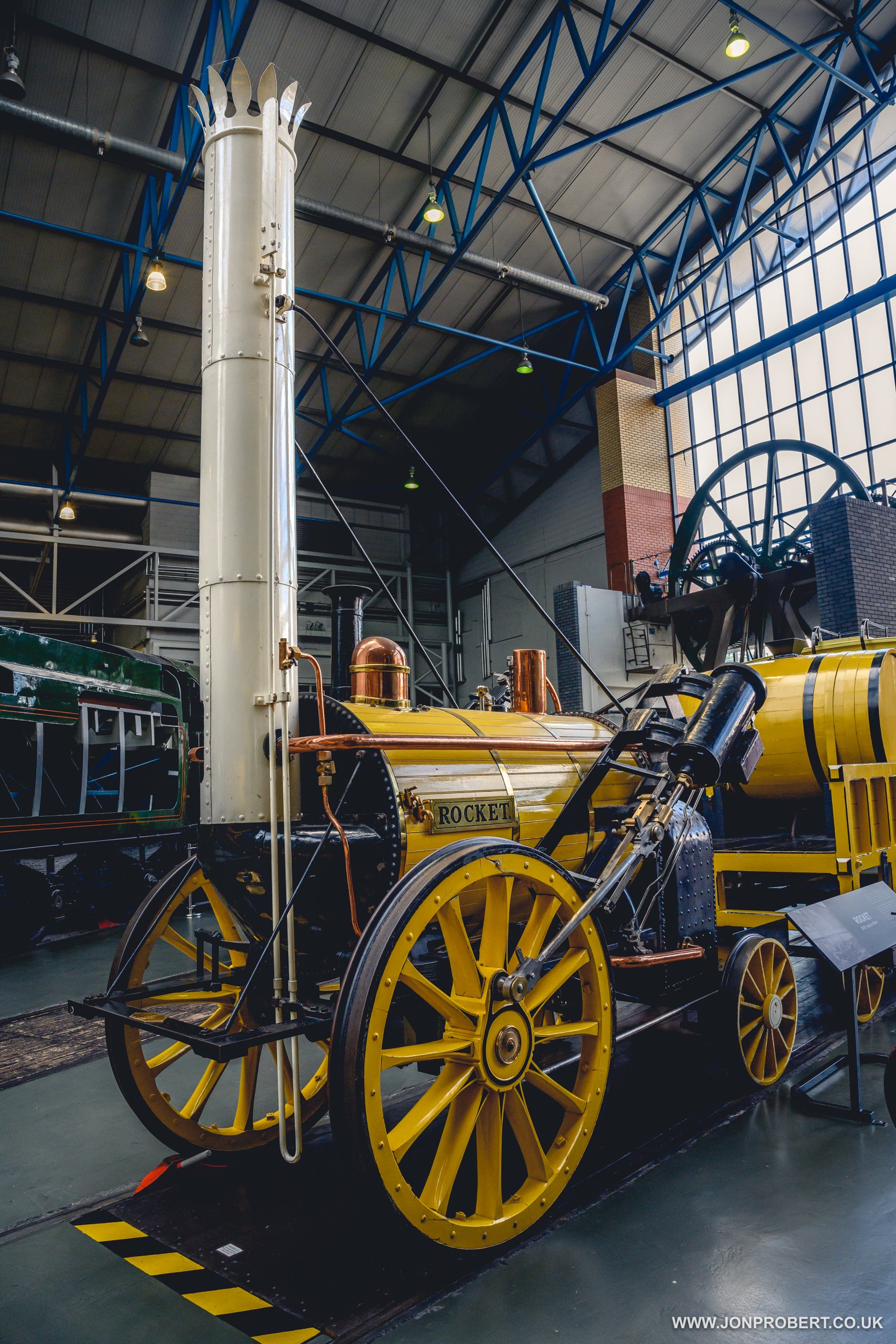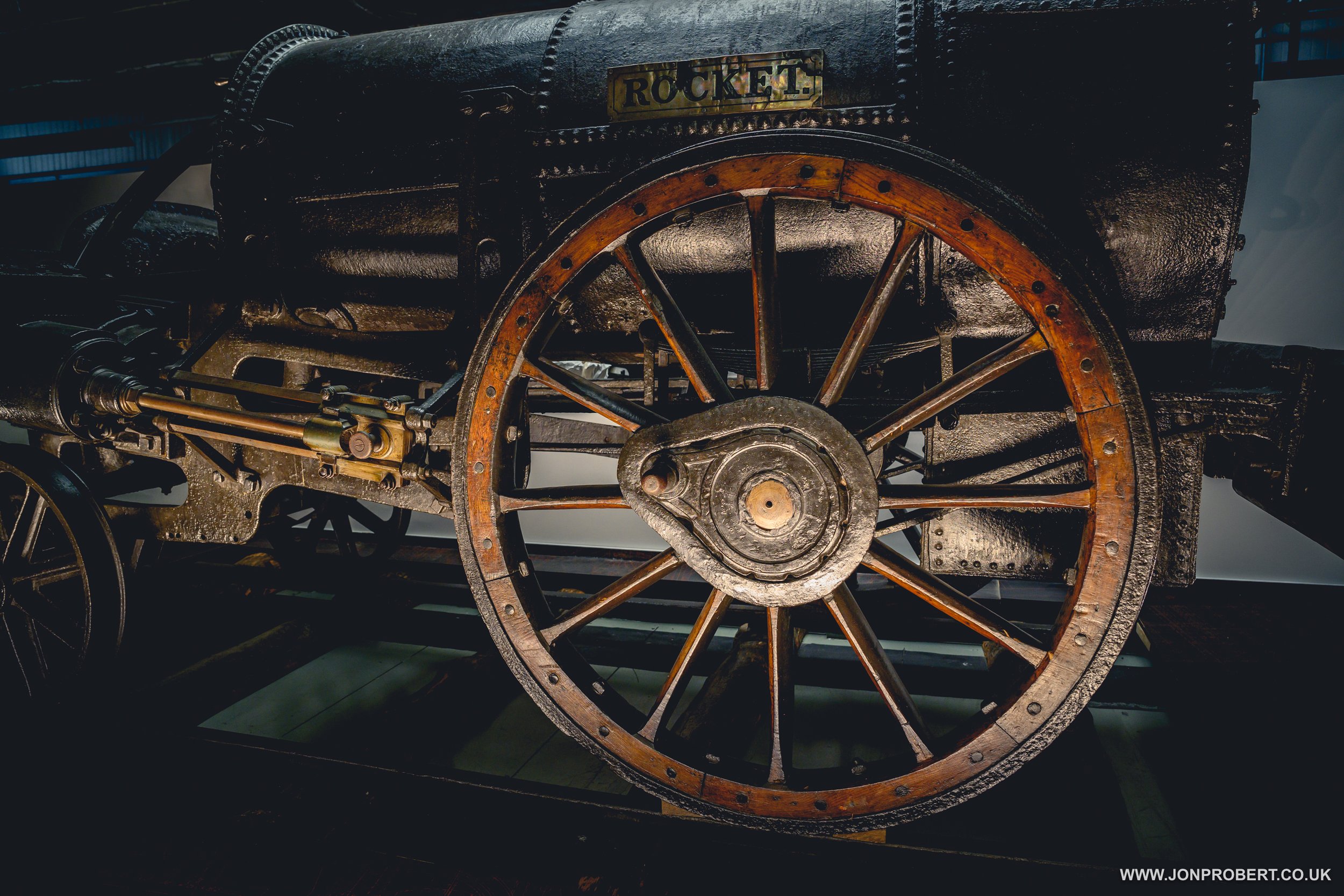Stephenson’s Rocket and the Rainhill Trials
Stay tuned for a video release of this content with more photographs and video from the National Railway Museum!
It is arguable that it was the railway engineers, and particularly the two Stephensons, that kick-started the Victorian age. Stephenson’s Rocket was built almost 200 years ago in 1829, and these days the original locomotive resides in the National Railway Museum in the city of York in the North of England. They also have a couple of replicas there; one of these is a cutaway demonstrator but the other is occasionally steamed up and pulls passengers up and down a short section of railway at the museum.
The 1936 replica of The Rocket at the National Railway Museum in York.
Many people are aware there were two great Stephensons: George born in 1781 and his son Robert born in 1803. However, it is less well known that there is opposing evidence on which of the two actually designed the famous locomotive. George Stevenson’s inventive and practical involvement with the development of The Rocket has been historically exaggerated, and we now know that it was his son Robert’s engineering talent that lead to its success.
The two men, though close, were quite complementary to one another in character. Without the combined drive and self-confidence of the Father, the brilliance of the self-doubting and easily discouraged Son might not have been realised.
Railways before The Rocket
George Stevenson was certainly not the inventor of the steam engine, but he built upon on the work of other engineers such as Richard Trevithic and William Murdoch in the early 1800s.
One of the issues with early steam locomotives was the huge weight of the machine required to equal the pulling power of horses. George Stevenson implemented changes to the brittle cast-iron rails that would often crack under the weight of the heavier engines built during this time. Instead, he used more malleable iron which could carry the weight of heavier locomotives without breaking.
One of the triggers for the development of The Rocket was the cotton industry. Due to the increasing costs of getting raw materials from the sea port in Liverpool to the Manchester mills, a 35 mile two-way railway for both passengers and freight was to be built. And George Stevenson was in fact chosen to be the chief engineer of this railway.
At its conception it wasn’t certain what would be the source of motive power on this new railway, as steam power was not actually a proven technology at the time.
There was also a level public unease over the effects of transporting people and freight at large speeds. Some people predicted there would be horrible impacts on both the human body, and the environments that the trains would pass through.
Design of The Rocket and the Rainhill Trials
The Rocket was the prototype for the steam engine as we now know it, and it was built in Newcastle in 1829. It certainly lacked any mod cons like vacuum brakes (in fact it no brakes at all). It didn’t even have a whistle.
Rocket was built to compete in a public competition proposed by the directors of the Liverpool & Manchester Railway, that promised prize money of £500 for the winner. This is approximately £52,000 in today’s money (or just over $64,000 US dollars for my friends across the pond).
The competition (which took place between the 8th and 14th of October 1829) was dubbed the Rainhill trials, and its purpose was to determine which locomotive would be used for the World’s first passenger carrying train.
The outcome of this trial would result in a transportation revolution.
The Rocket’s Innovative Design
The Rocket featured breakthroughs in locomotive design that ultimately lead to it winning the trial. One reason for this was its increased power and speed relative to its weight.
It was the secretary of the Liverpool & Manchester Railway, Henry Booth, who had a hand in one of the most important innovations of The Rocket. This was to change the way in which the fire heated the water in the boiler. In existing designs the fire burned in a single tube, but in Rocket this was replaced with a multi-tube design. To compare it to another loco of the age, Instead of the single 500mm diameter tube that ran through George Stevenson’s Locomotion, Rocket featured 25 tubes, each of which was 75mm in diameter.
Crunching the numbers we find that 1 tube x 500mm diameter x 2800mm long, versus 25 tubes x 75mm diameter x 1800mm long, results in over twice the heat transfer area for the much lighter and smaller boiler. This design was the key to producing the high power needed, whilst conforming with the trial’s weight limit. It could be said that without this increased heat transfer area design, the outcome of the trials might have been very different.
Another innovation of The Rocket was its blast-pipe design. Early steam locomotives exhausted waste steam from the cylinders straight to the atmosphere. Robert Stephenson developed this idea by directing the exhaust steam to the base of the chimney, thereby causing a low pressure on the downstream side of the boiler tubes. This had the effect of drawing flue gases from the fire out through the tubes and pulled more air and oxygen up through the fire. In turn, this caused the fire to burn more fiercely, producing more heat as the engine was driven faster.
The Rules
Entrants of Rainhill trial were required to complete 20 return trips of a 1¾ mile level stretch of line at Rainhill near Liverpool. Each locomotive could not weigh above 4.5 tons (T-O-N-S) as to not overload the rails, and is probably what led to Robert choosing wooden wheels for Rocket. Each locomotive also had pull 3 times its own weight, and achieve an average speed of at least 10mph.
The remains of The Rocket at the National Railway Museum in York
The Trial
There were ten initial entries but only three were real contenders. John Braithwaite and John Ericsson’s Novelty, Timothy Hackworth’s Sans Pareil, and of course Stephenson’s Rocket.
Rocket started the proceedings by undertaking the trial first. It performed well, reaching a maximum speed of 24mph with an average of 14, which even included the 14 minutes turnaround time halfway through that they needed to take on water and fuel.
Next to take on the challenge was Novelty. It must have been a nerve wracking time for the Stephenson’s when Braithwaite and Ericsson’s locomotive set off at a blistering pace. In fact, during a demonstration run, the engine achieved a speed of 30mph with passengers aboard. During the trial however, disaster struck when the boiler was starved of water and the loco had to be stopped to carry out repairs.
Whilst repairs were carried out on Novelty, Timothy Hackworth prepared to put Sans Pareil through its paces. The engine ran at reasonable speeds up to 15mph, but used fuel inefficiently and was over the weight stipulated in the trials’ rules. The engine ended up failing half way through the run due to a dodgy water supply to its boiler, and withdrew from the trial.
On a second run at the challenge, Novelty actually ran well until a boiler tube eventually ruptured, causing its fire to be quenched and the locomotive was put out of the race once and for all. If it were not for this sequence of events we can see that perhaps the outcome of the competition was not as clear cut as some might think. A detailed record of the trial was published in Mechanics’ Magazine that clearly showed that some thought the outcome unjust:
The directors had no alternative [to award the prize] since ‘The Rocket’ was the only engine that fulfilled the conditions of the competition. There are people here however that think that the interests of the public would have been quite as well served, had the directors adjudged the premium on a more general view of the matter, and conferred it on that engine which is on the whole ‘the most improved’.
Mechanics’ Magazine, 31st October 1829
In the end though, it was only The Rocket that satisfied the requirements of the trial completely and fully deserved the prize that was awarded. The £500 was shared between George Stephenson, Robert Stephenson and Henry Booth.
The legacy of Rocket
Even though The Rocket only spent a short time in service on the Liverpool & Manchester railway, the Rainhill trials had made the engine famous and this was used to great advantage by the company as a marketing tool. It was a shining symbol of engineering pedigree and modern design.
After the trials there was a wave of interest in the railway. George Stephenson himself drove inquisitive people up and down the line to drum up public approval. Notable actress of time, Fanny Kemble was quite ecstatic about her 35mph footplate ride:
I stood up, and with my bonnet off drank the air before me… When I closed my eyes the sensation of flying was quite delightful, and strange beyond description. Yet, strange as it was, I had a perfect sense of security, and not the slightest fear. Now, a word or two about the master of all these marvels with whom I am most horribly in love… He is a man from 50 to 55 years of age; his face is fine, though careworn, and very original, striking and forcible. He has certainly turned my head.
Fanny Kemble
Not everything went smoothly however. In fact, MP for Liverpool at the time, William Huskisson, ended up getting his leg crushed by Rocket’s driving wheel at the opening of the railway in September 1830.
Regardless though, The Rocket left a great legacy and had a significant impact on the design of steam locomotives going forwards. From the blast pipe, to the increased heat transfer area of the boiler tubes, so many aspects of The Rocket were seen in locomotive design right up to the last engine produced for British Railways, Evening Star.
References
Stephenson’s Rocket and the Rainhill Trials (2010) Richard Gibbon ISBN 978 0 74780 803 9
George and Robert Stephenson - The Railway Revolution (1960) L.T.C Rolt






